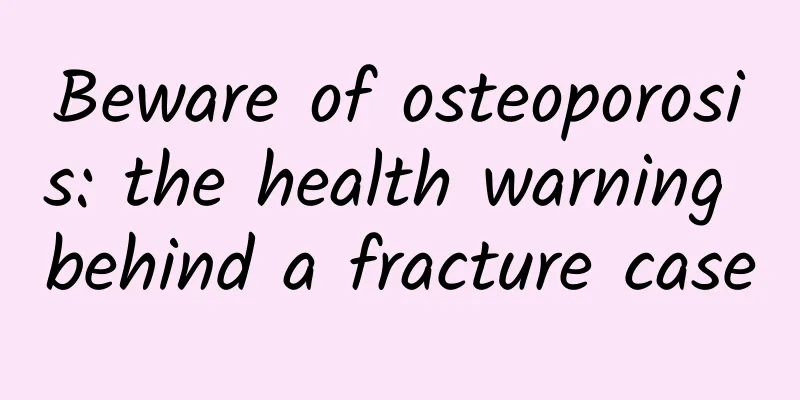Beware of osteoporosis: the health warning behind a fracture case

|
Aunt Wang, 66 years old, sneezed when she woke up in the morning and suddenly felt unbearable pain in her waist. Not only could she not get out of bed, she even had difficulty turning over in bed. She went to the emergency room of the hospital, where the doctor diagnosed her with osteoporosis and lumbar compression fracture. Aunt Wang was very puzzled: "I didn't fall, how come I broke my bone?" The doctor patiently explained, "Auntie, judging from your current condition, it is probably related to osteoporosis. Sometimes just sneezing, bending over, or even being bumped in a car can cause a fracture. You need to be hospitalized for treatment." Aunt Wang went to the inpatient department and completed a complete examination. When the bone density report came out, the T value was -3.2, and she was diagnosed with osteoporosis. The director gave two treatment options: one is conservative treatment, which requires the bed rest time to be determined according to the specific condition, and anti-osteoporosis drug treatment at the same time; the other is surgical treatment, which requires percutaneous kyphoplasty (PKP) under local anesthesia. The patient must stay in bed for 6 hours after the operation and can walk after 24 hours. The surgical mechanism is as follows: (1) Vertebral reduction and repair. During PKP surgery, the doctor will form a cavity in the patient's vertebral body and inject high-viscosity bone cement into the cavity through a special balloon. The expansion of the balloon can restore the original height and shape of the fractured vertebra and reposition it. (2) Bone cement filling and stabilization. Bone cement is injected into the cavity, filled and solidified, providing internal support and reinforcement. Through the solidified bone cement, PKP can achieve stable repair of the vertebral body. (3) Pain relief. PKP surgery can reduce or eliminate the pain caused by compression fractures through vertebral reduction and bone cement filling, and improve the patient's daily quality of life. (4) Promote fracture healing. Bone cement filling can stimulate the bone tissue around the fractured vertebra, stimulate the bone healing process, and promote fracture healing. Aunt Wang chose surgical treatment and had the surgery the next day after a complete examination. After returning to the ward after the operation, Aunt Wang was surprised to find that the symptoms of low back pain had basically disappeared. On the third day, Aunt Wang was discharged from the hospital after getting out of bed. PKP surgery greatly shortened the course of the disease and also avoided a series of complications caused by bed rest. Aunt Wang was very satisfied with the results of the surgery. However, before being discharged from the hospital, the doctor still explained many precautions: (1) Osteoporosis is a chronic disease that requires long-term medication and regular check-ups. Bone metabolism is relatively slow, and the increase in bone mass cannot be seen in a short period of time. Medication should still be continued after the pain symptoms are relieved. At the same time, it is recommended to conduct bone density testing every 1 to 2 years to timely understand bone changes and adjust treatment strategies. (2) Patients with osteoporotic fractures should start rehabilitation exercises as soon as possible without affecting fracture recovery. Some resistance exercises and weight-bearing exercises can be gradually started, such as Tai Chi, jogging, and exercises, to enhance muscle strength, thereby enhancing the body's coordination and responsiveness. (3) Regarding calcium supplementation, calcium supplementation is not simply "eating it", the important thing is "effective absorption". The role of sunbathing is to supplement vitamin D, which can promote calcium absorption, but you cannot sunbathe through glass. For the elderly, dairy products such as milk and yogurt are good sources of calcium, but for those who are lactose intolerant, you can choose calcium-fortified plant milk or calcium supplements. Other foods rich in calcium include sesame paste, soy products, nuts, dried shrimps, etc. When choosing a calcium source, calcium and iron should be avoided at the same time, because the interaction between them may affect absorption. For people over 50 years old, the recommended calcium intake is 900-1200 mg/d, and the vitamin D intake dose is 800-1200 IU/d. (4) Pay attention to safety and prevent falls. In the home environment, the elderly should minimize the risk of falls. For example, use anti-slip mats, handrails and ensure good lighting indoors, and wear anti-slip shoes when going out. Maintaining a safe living environment can effectively reduce the probability of fractures. (5) Wear a brace correctly. Wearing a thoracolumbar orthotic brace after PKP surgery can reduce the risk of postoperative vertebral fractures, as well as adjacent vertebrae and intervertebral fractures. It is recommended to wear a back brace early, in a standardized manner, and for a long time (at least 3 months). Compared with people who have never had a fracture, patients with osteoporotic fractures face a higher risk of re-fracture. Therefore, it is particularly important to take effective measures to reduce the possibility of re-fracture. In daily life, adhere to anti-osteoporosis drug treatment, ensure the continuity of treatment, regularly check bone density, adjust treatment plans in a timely manner, pay attention to safety and prevent falls, avoid potential risk factors to the greatest extent, and insist on exercise, strengthen nutrition, and maintain a healthy lifestyle. This can effectively reduce the incidence of re-fracture and enjoy a happy old age. (Author: Li Yun, Cao Fujiang, Li Xiaojing, Department of Orthopedics, Tianjin Medical University General Hospital) |
Recommend
Will I get fat if I take the menstruation regulating and pregnancy promoting pills?
What most women are most worried about is probabl...
How painful it is to have a fallopian tube intubation? You will know after watching the process.
There are many reasons for fallopian tube blockag...
What are the symptoms of postpartum vaginitis?
If a mother has vaginal problems after childbirth...
What to do if your endometrium becomes inflamed
What many women fear most is the occurrence of gy...
Does painless abortion hurt?
Modern society is very open. Many young men and w...
Pictures and symptoms of vulvar ringworm
Vulvar tinea, also known as vulvar leukoplakia, i...
What is the cause of the lump in the breast?
Studies have shown that breast cancer has become ...
How to prevent pregnancy after removing the IUD
Women who have installed contraceptive rings must...
How to solve the problem of excessive leucorrhea
Female friends are all familiar with leucorrhea. ...
What does "hemorrhoids" feel like? Come in and experience it~
What does hemorrhoids feel like? Those who have e...
Is breast reduction surgery dangerous?
In our lives, there are always some people who th...
What to do if you have body odor after giving birth
After giving birth, every mother needs to pay att...
[Technology benefits the people] Our hospital's ophthalmology department independently carried out the first highly difficult level 4 surgery - vitrectomy, and the patient regained clear vision
Recently, the Department of Ophthalmology of our ...
What to do if you have abdominal pain during pregnancy
Many women will encounter this problem of abdomin...
How to reduce belly fat for girls
In our daily life, many women sit in the office f...









